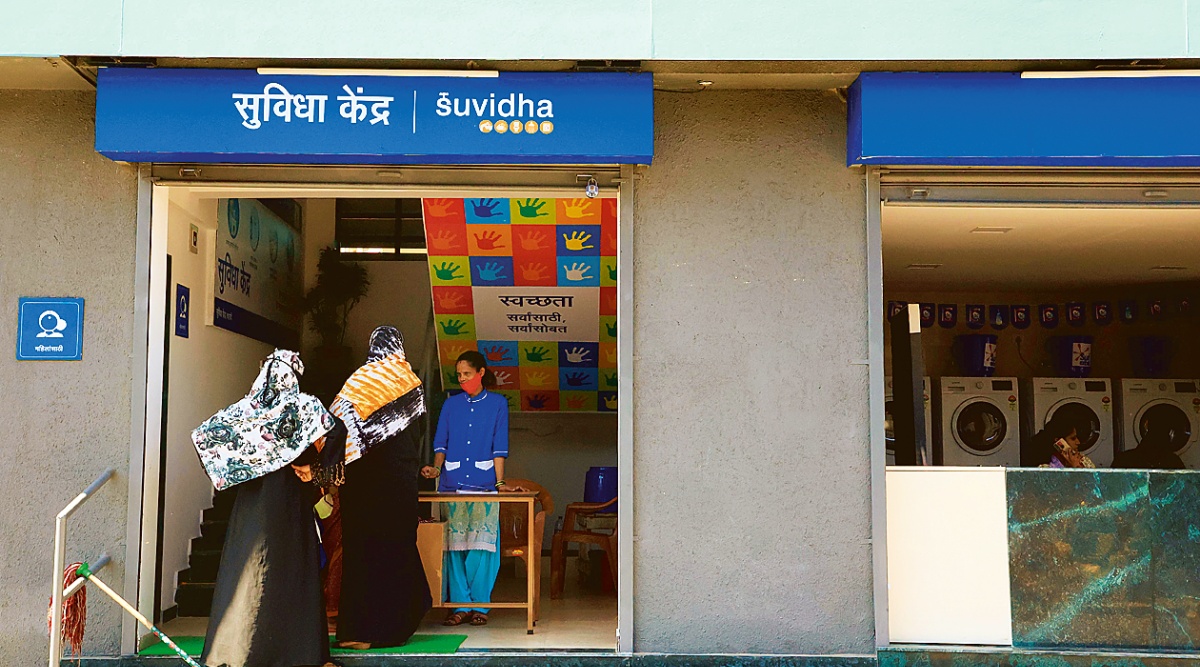 The 6,000-sq-ft Suvidha Centre is spread across two storeys. (Amit Chakravarty)
The 6,000-sq-ft Suvidha Centre is spread across two storeys. (Amit Chakravarty) A TWO-STOREY building, with 111 toilet seats, shower rooms, washing machines, cold and hot water dispensers, sanitary napkin vending machines, and night-time facilities, the 6,000 sq ft ‘Suvidha Centre’ inaugurated by Maharashtra Tourism Minister Aaditya Thackeray in Dharavi on February 9 is being touted as one of the largest public toilet blocks in the country.
It’s not that what impresses Soni, but two other crucial features – that the toilet block is “well-lit” and “secure”. Born, raised and married in this Mumbai slum, and now in her 20s, Soni knows the value of both, having spent a lifetime queuing up outside community toilets every morning, mostly drawing water for use from large drums.
She is “used to the hustle”, she says. But it’s the fear that would follow every time she stepped out in the dark to use the public toilet that she could never handle. Soni, who now uses the new toilet block, says, “It is next to my lane, the walkthrough is well-lit. It is clean and has running water… The security doesn’t allow men to linger, which is good.”
Harshada Doiphode, a Dharavi-based social worker, says, “Many pay-and-use toilets in the area are decrepit, with doors or ventilation panes broken. Girls and women would go in pairs or groups to use them. A few would use the toilet only once a day even if their bladder was bursting, causing infection and health problems.”
Among the facilities at the new block is a panic button in the women’s toilets.
Like her neighbours, Soni and her family of five share a 10X10 ft shanty. Dharavi’s maze of tiny alleys are home to nearly one million residents. Between them, the 10-lakh people have 339 pay-and-use or free community toilets, at least 19 added during the pandemic period. Hardly anyone has a private toilet.
The new multi-storey buildings built to house the slum residents also have a common toilet block per tower, with on an average four seats and two bathrooms.
Soon after the pandemic began, amidst the panic that Dharavi might become a virus hotspot, there was a drive to sanitise the public toilets. Soni recalls those days when the toilets were “cleaned properly, twice a day”.
For use of the new toilet block, one can avail passes, which allow a family of five access for Rs 150 a month (effectively meaning Rs 1 per person per day) — the same rate as in the pay-and-use public toilets in Dharavi. Without the pass, residents have to pay Rs 3 for using the toilets. Children are allowed free access.
Cold water is provided for Rs 1 a litre and hot water for Rs 2. For use of the shower cubicles, eight in all, the charge is Rs 5, and Rs 10 if you want a bar of soap.
Fourteen staffers are deployed to clean the toilets every hour. At the old pay-and-use toilets, cleaning was ‘officially’ done twice a day.
The representative of Hindustan Unilever Limited, which is managing the unit along with HSBC India and an NGO, says they have provided passes to 100 families.
Ten more Suvidha Centres are planned in slum areas across Mumbai, including one more in Dharavi.
Gathered around the Dharavi Suvidha Centre, a group of women including Zeenat Adam Kabri, a mother of five, hope there will be more such facilities. Kabri wishes though that instead of the 10 washing machines at the centre, charging Rs 50 for a bucket of clothes, the authorities had spent some of the “crores” to create community spaces for children like hers. “Do we have money to spend on washing clothes? We can wash clothes ourselves,” she says.
However, many of the Dharavi residents are migrants who live alone, away from their families, and they are happy about the washing services. Gyanchand Kantaprasad Jaiswal, who works with a local NGO, says, “At least 40% of the population are migrant labourers. The current laundry services charge Rs 30 for washing and ironing a pair of clothes. In comparison, at the Suvidha Centre, they can get at least four-six clothes washed for Rs 50.”
Sudhir Nimbalkar, assistant engineer and in-charge of the Dharavi Suvidha Centre, says he is aware of the residents’ issues, including the fact that some are intimidated by the “swanky building”. “But I am hopeful that with word of mouth and good-quality sanitation services, it will be used to its maximum capacity within months.”
Next to the shiny new community space, a dilapidated toilet unit lies almost unused now. Jaiswal says: “Before this new facility came up, some men used it, but no woman felt safe here. They preferred walking to the toilets on the main road.”
As two more women enter the Suvidha Centre to enquire about the monthly passes, Soni glances over at the dilapidated toilet and makes a wish: that the new facility remains accessible and clean. And that the lights don’t go out.
- The Indian Express website has been rated GREEN for its credibility and trustworthiness by Newsguard, a global service that rates news sources for their journalistic standards.

